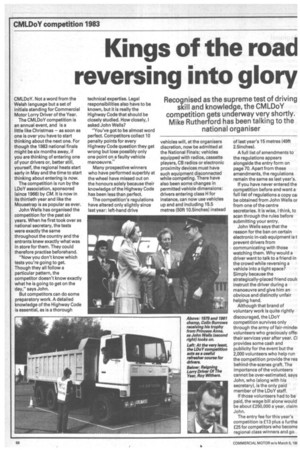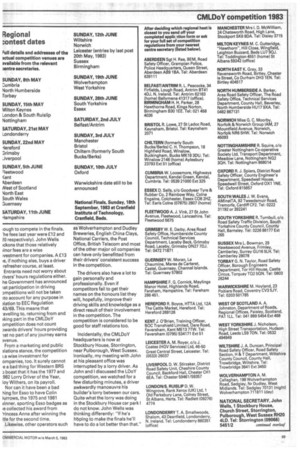Kings of the road reversing into glory
Page 70

Page 71

If you've noticed an error in this article please click here to report it so we can fix it.
Recognised as the supreme test of driving skill and knowledge, the CMLDoY competition gets underway very shortly. Mike Rutherford has been talking to the national organiser
CMLDoY. Not a word from the Welsh language but a set of initials standing for Commercial Motor Lorry Driver of the Year.
The CMLDoY competition is an annual event, and is a little like Christmas — as soon as one is over you have to start thinking about the next one. For though the 1983 national finals might be six months away, if you are thinking of entering one of your drivers or, better still, yourself, the regional heats start early in May and the time to start thinking about entering is now.
The competition is run by the LDoY association, sponsored (since 1966) by CM. It is now in its thirtieth year and like the Mousetrap is as popular as ever.
John Wells has organised the competition for the past six years. When he first took over as national secretary, the tests were exactly the same throughout the country and the entrants knew exactly what was in store for them. They could therefore practise beforehand.
"Now you don't know which tests you're going to get. Though they all follow a particular pattern, the competitor doesn't know exactly what he is going to get on the day," says John.
But competitors can do some preparatory work. A detailed knowledge of the Highway Code is essential, as is a thorough technical expertise. Legal responsibilities also have to be known, but it is really the Highway Code that should be closely studied. How closely, I asked John Wells?
"You've got to be almost word perfect. Competitors collect 10 penalty points for every Highway Code question they get wrong but lose possibly only one point on a faulty vehicle manoeuvre."
Many prospective winners who have performed superbly at the wheel have missed out on the honours safely because their knowledge of the Highway Code has been less than perfect.
The competition's regulations have altered only slightly since last year: left-hand drive vehicles will, at the organisers discretion, now be admitted at the National Finals; vehicles equipped with radios, cassette players, CB radios or electronic proximity devices must have such equipment disconnected while competing. There have also been some changes in permitted vehicle dimensions: drivers entering class H for instance, can now use vehicles up and and including 15.5 metres (50ft 10.5inches) instead of last year's 15 metres (49ft 2.5inches).
A full list of amendments to the regulations appears alongside the entry form on page 70. Apart from these amendments, the regulations remain the same as last year's.
If you have never entered the competition before and want a full list of regulations a copy cal be obtained from John Wells or from one of the centre secretaries. It is wise, I think, to scan through the rules before submitting your entry.
John Wells says that the reason for the ban on certain electronic in-cab equipment is t prevent drivers from communicating with those watching them. Why would a driver want to talk to a friend in the crowd while reversing a vehicle into a tight space? Simply because the strategically-placed friend caul( instruct the driver during a manoeuvre and give him an obvious and distinctly unfair helping hand.
Although that brand of voluntary work is quite rightly discouraged, the LDoY competition survives only through the army of fair-mindel volunteers who graciously offel their services year after year. 0 provides some cash and publicity for the event but the 2,000 volunteers who help run the competition provide the rea behind-the-scenes graft. The importance of the volunteers cannot be over-estimated, says John, who (along with his secretary), is the only paid member of the LDoY staff.
If those volunteers had to be paid, the wage bill alone would be about £250,000 a year, claim John.
The entry fee for this year's competition is £13 plus a furthe £25 for competitors who become regional class winners and go lough to compete in the finals. he fees last year were £12 and ?0 respectively). John Wells :ckons that those relatively iinor fees are a wise 'vestment for companies. A £13 :e, if nothing else, buys a driver refresher course, at least. Entrants need not worry about rivers' hours regulations either. he Government has announced at participation in driving Dmpetitions will not be taken ito account for any purpose in ?dation to EEC Regulation 43/69. This means that avelling to, returning from and iking part in the CMLDoY ampetition does not count Dwards drivers' hours providing lat no part of any journey earns avenue.
From a marketing and public ?dation& stance, the competition a wise investment for ompanies, too. It surely cannot e a bad thing for Western BRS 3 boast that it has the 1977 and 982 Lorry Driver of the Year, Ioy Withers, on its payroll. Nor can it have been a bad hing for Esso to have Colin lurrows, the 1975 and 1981 vinner, sporting Esso badges as le collected his award from 'rincess Anne after winning the Ale for the second time. Likewise, other operators such
as Wolverhampton and Dudley Breweries, English China Clays, National Carriers, the Post Office, British Telecom and most of the other major oil companies can have only benefitted from their drivers' consistent success in the competition.
The drivers also have a lot to gain personally and professionally. Even if competitors fail to get their names on the honours list they will, hopefully, improve their driving skills and knowledge as a direct result of their involvement in the competition. The competition is considered to be good for staff relations too.
Incidentally, the CililLDoY headquarters is now at Stockbury House, Storrington, near Pulborough, West Sussex. Ironically, my meeting with John at his pleasant office was interrupted by a lorry driver. As John and I discussed the LDoY competition, we watched for a few disturbing minutes, a driver awkwardly manoeuvre his builder's lorry between our cars. Quite what the lorry was doing in the Stockbury House car park I do not know. John Wells was thinking differently: "If he's hoping to make the finals he'll have to do a lot better than that."












































































































